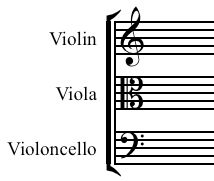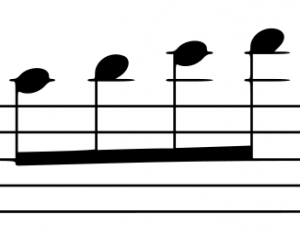Staff
What is a Staff?
In musical notation, the “staff” is a set of five lines and four spaces. Each line and space corresponds to one of the white keys on the piano, so staffs are usually easiest to read on pianos and other keyboard-based instruments. But this kind of musical notation is used for many other instruments as well.
Here’s an example of one kind of musical staff with the names of each note.
Staffs and Clefs
When reading a staff, the most important step is to notice the clef. That’s a large symbol on the far right of the staff. Depending on what clef you see, the lines and spaces will be named for different notes! The image above was a treble clef (), which has one set of notes; here you can see a bass clef (
) with its notes. Notice how different they are! There are ways to memorize these different sets of notes, which we’ll go over in the last section.
Other Marks
Brace
The black curvy line here is called a “brace.” It connects two staffs with different clefs on them. Altogether, when you have two staves connected by a brace in this way, it’s called a grand staff. This symbol is very common in piano music, where the grand staff is split between right and left hands: on the higher staff, you’ll see the notes for your right hand. On the lower staff, you’ll see the notes for your left hand.
Bracket

Ledger line

Why is the Staff Important?
The staff is like a Christmas tree, and the notes are like decorations: the staff provides a structure for you to place each note where it belongs! Without the staff, it would be very difficult for us to read music!
If you’re learning to play the piano or any orchestral instrument, the staff is absolutely essential. Every piece of music is written in musical notation, with the staff laid out as you see here. There are a few instruments, such as drums and guitar, that have their own system of notation called tabs, so some guitarists and drummers do not use the staff. But even for them, it’s better to understand how music is written — after all, classical guitar is a beautiful style to learn, and most of those songs are written with staffs! Overall, it’s always good to develop broad, flexible skills that you can transfer from one instrument to the next, and reading music off a staff is one of the most flexible skills you can learn.
How to Read a Staff
When reading a staff, all you have to do is count the lines — lower notes will be at the bottom, and higher notes at the top! More specifically, each line or space represents a specific note on your instrument.
When you first learn musical notation, the teacher almost always gives you “mnemonics” or little rhymes that you can use to work out the meaning of the lines and spaces on the staff. If you get confused at any point, go back to the images in Section 1 and notice how these mnemonics line up with the notes on the staff.
The mnemonics only cover the notes “within” the staff. But there are also extra notes written above and below the staff, with little shorter lines through them to mark how they relate to the staff. For example, in the image from Section 1 the first note is “C,” and the note has a ledger line through it. Don’t worry about these extra notes for now, just remember these mnemonics for the notes inside the staff:
LINES of the Treble Clef: E-G-B-D-F
“Every Good Boy Does Fine”
SPACES of the Treble Clef: F-A-C-E
“Face!”
LINES of the Bass Clef: G-B-D-F-A
“Good Boys Do Fine Always”
SPACES of the Bass Clef: A-C-E-G
“All Cows Eat Grass”
Try coming up with your own mnemonic for the lines and spaces in each clef — you might find it easier to remember that way!

